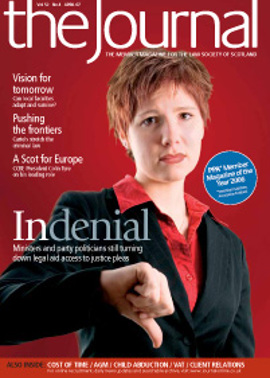Planning with people

“Planning is important. It really matters. The planning system is there to promote, facilitate and regulate development in the public interest. Development is essential if we are to meet current and future economic, social and environmental challenges. These challenges require mineral and energy resources, jobs, homes, schools, hospitals, leisure and recreation facilities” (Planning Advice Note 81: “Community Engagement- Planning With People”, Scottish Executive, 2007).
The biggest reforms to the planning system since its creation 60 years ago are now underway. The Planning etc (Scotland) Act 2006 was passed in November 2006 but is not yet in force (pending the secondary legislation and policies required to enable the new reforms). Media coverage has largely centred on whether planning permissions for house extensions, loft conversions and conservatories might be abolished – but the reforms will extend far further than that.
Certainly the current sprawling, confusing, bureaucratic system dearly needs to be improved – to streamline it, make it more comprehensible and encourage communities to get involved in it. It is with this last aim in mind that the Scottish Executive recently published Planning Advice Note 81. This contains new advice on best practice for stimulating effective community engagement in planning decisions.
Opposing sides
Well, policies come and policies go, you might say, and this one won’t be the last. The planning system is already bursting at the seams with official guidance and policies anyway – will one more make any difference? Indeed cynics may scorn the very idea of local communities having an effective say in planning decisions. Many believe the system long ago lost sight of putting people and communities first but simply became focused on the needs of business, a “developers’ charter”.
In reality things have never been that simple. Yes, the planning system created in 1947 appears to have been largely designed to regulate new building and changes in land use. Yes, it also introduced the (then unknown) concept of needing to apply for planning permission to build on one’s own property. But it was also designed to allow central and local government to reconstruct a country ravaged by war and improve the lives of people and communities much affected by it.
The planning system’s traditional primary purpose was therefore to arbitrate on whether land was suitable for the houses, factories, offices or other developments proposed for it. Councillors (or government ministers) then assessed whether wider social and economic benefits outweighed local impacts, environmental or otherwise. Planners have often (usually unfairly) been accused of favouring one side or the other, usually when a major development proposal has polarised public opinion “for” or “against” its social and economic benefits (particularly jobs) as compared to its environmental impacts.
Inclusive system?
But however laudable the original purposes of the system, it is unfortunately true that community engagement has hitherto often been an adversarial process in which community groups “defend” their areas against “hostile” developers. It has rarely been a process in which communities, developers and local authorities work together to shape the evolution of the areas in which they share a common interest. This is the aim behind Planning Advice Note 81.
Of course, formal guidance alone would do little to produce the major changes required. The true significance of Planning Advice Note 81 is that it describes quite succinctly what the whole of the new planning system will be designed to achieve – an inclusive and accessible system centred around community engagement. Of particular interest is that the new Act stipulates (in s 11) that major developments will require a mandatory pre-application community consultation of at least 12 weeks, and submission (with the subsequent planning application) of a “pre-application consultation report” (in a form yet to be prescribed).
Due to come into force in 2008, the Act will also provide for many other measures designed to improve the chances of effective community engagement taking place before key planning decisions are made and options closed off. This will require developers to spend considerably more time (and money) on consultation before many planning applications for major developments are even submitted to the planning authority (though developers should remember the Act does not include the third party right of appeal against planning decisions originally demanded by many community representatives).
Hopefully the new planning system will indeed stimulate improved community engagement. However, in the climate change era, it is increasingly hard to separate global effects on people and the environment from the more localised issues of land use suitability, economics and jobs which planning decisions have always involved. Even if communities do gain greater involvement in their own future, they will need to “think global, act local” more than ever – and accept that there are rarely easy answers if they do so.
Robin Priestley, Planning & Environment Group, Anderson Strathern
In this issue
- The bigger picture
- Citizen justice
- Purely rhetoric?
- Purely rhetoric? (1)
- Profit, team by team
- Bring them home
- Bring them home (1)
- Local roots
- Wanted! (for conspiracy)
- One voice
- AGM report
- Dealing positively with client concerns
- Block fees: the story behind the changes
- Think before you charge
- For the high jump
- Jury questions
- Put to the test
- Yet another expense
- Planning with people
- Lifting the lid
- Website reviews
- Book reviews
- Home is where the heart is
- PSG - new certificate of title
- SEPA: apply online and save
- SEPA: apply online and save (1)






